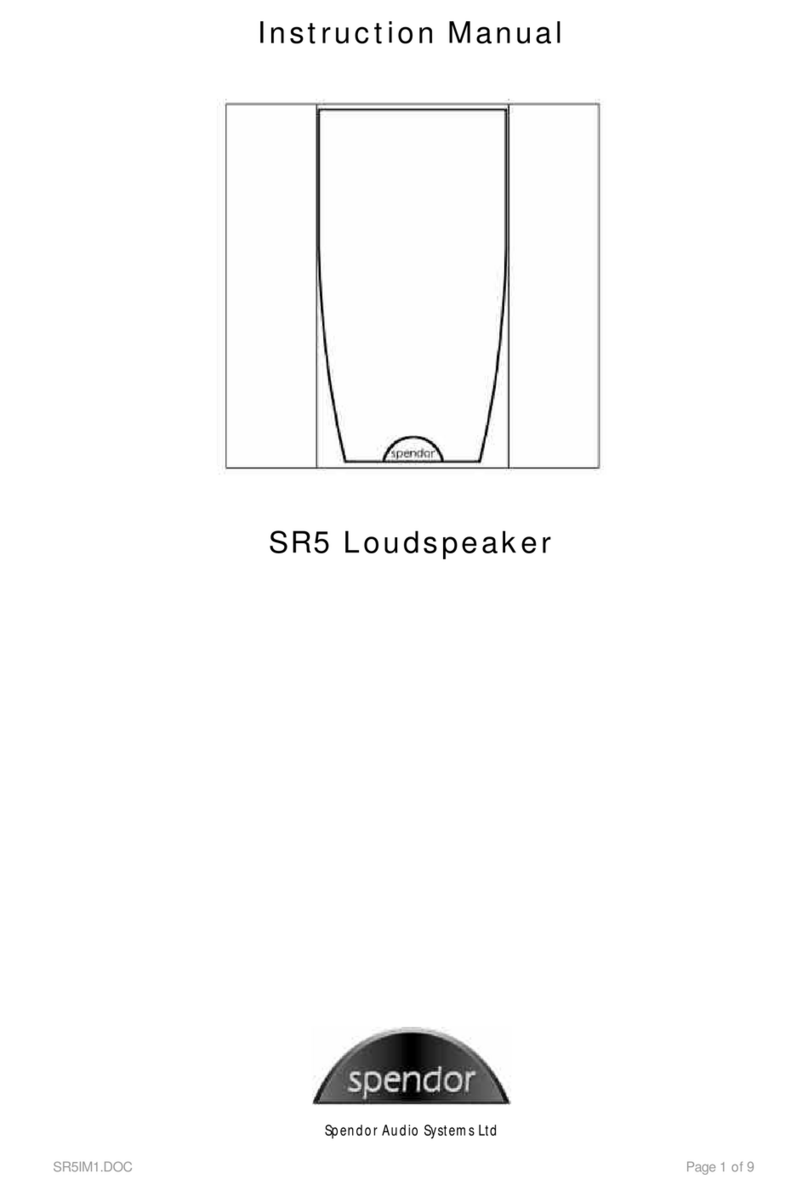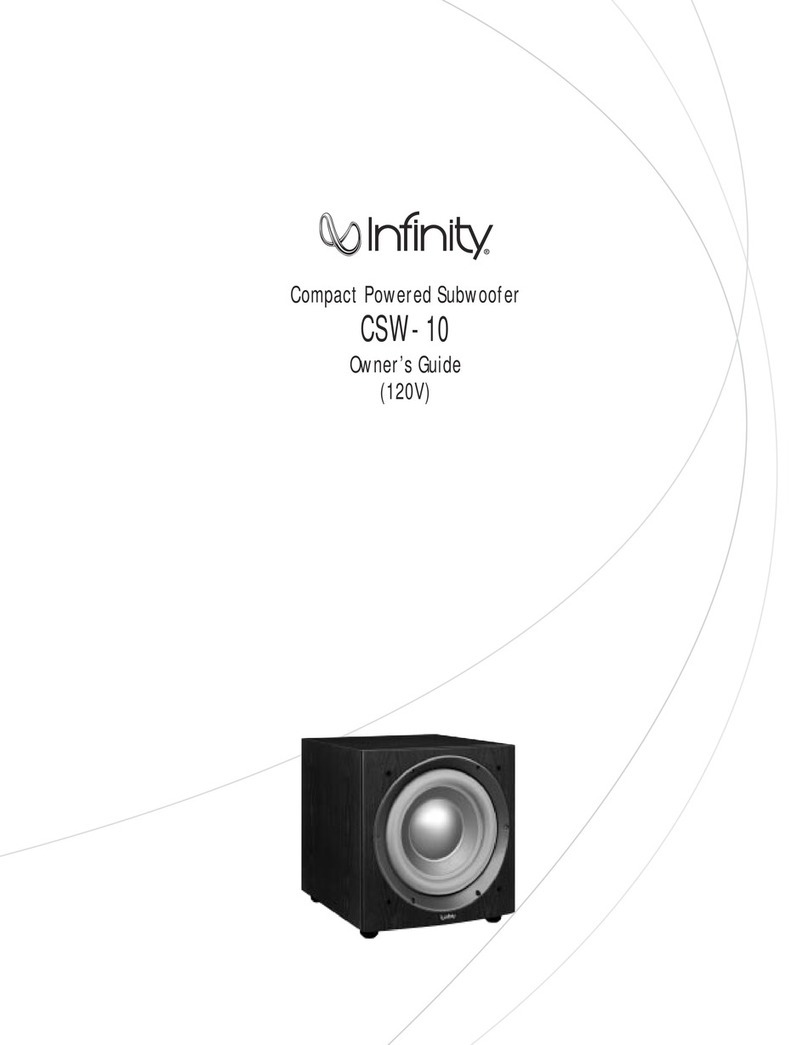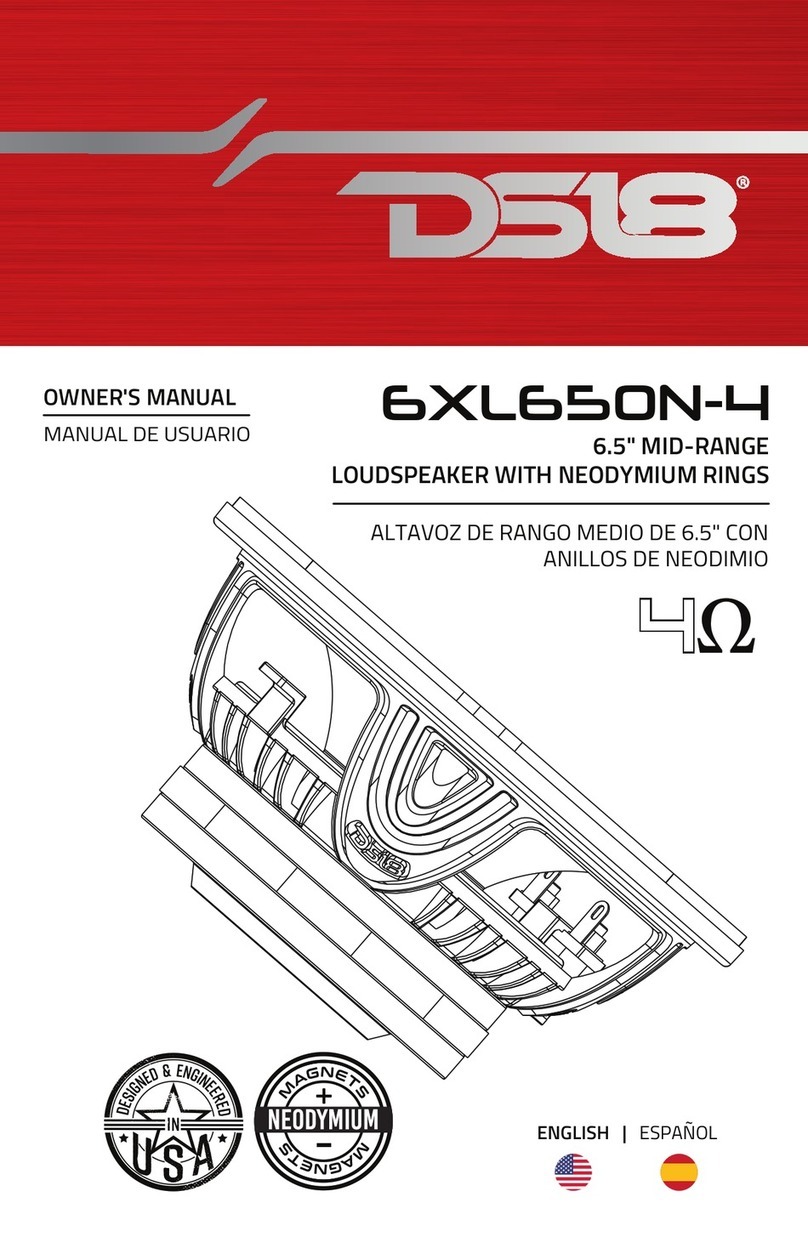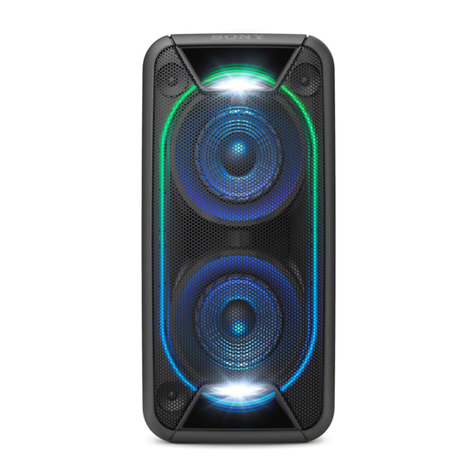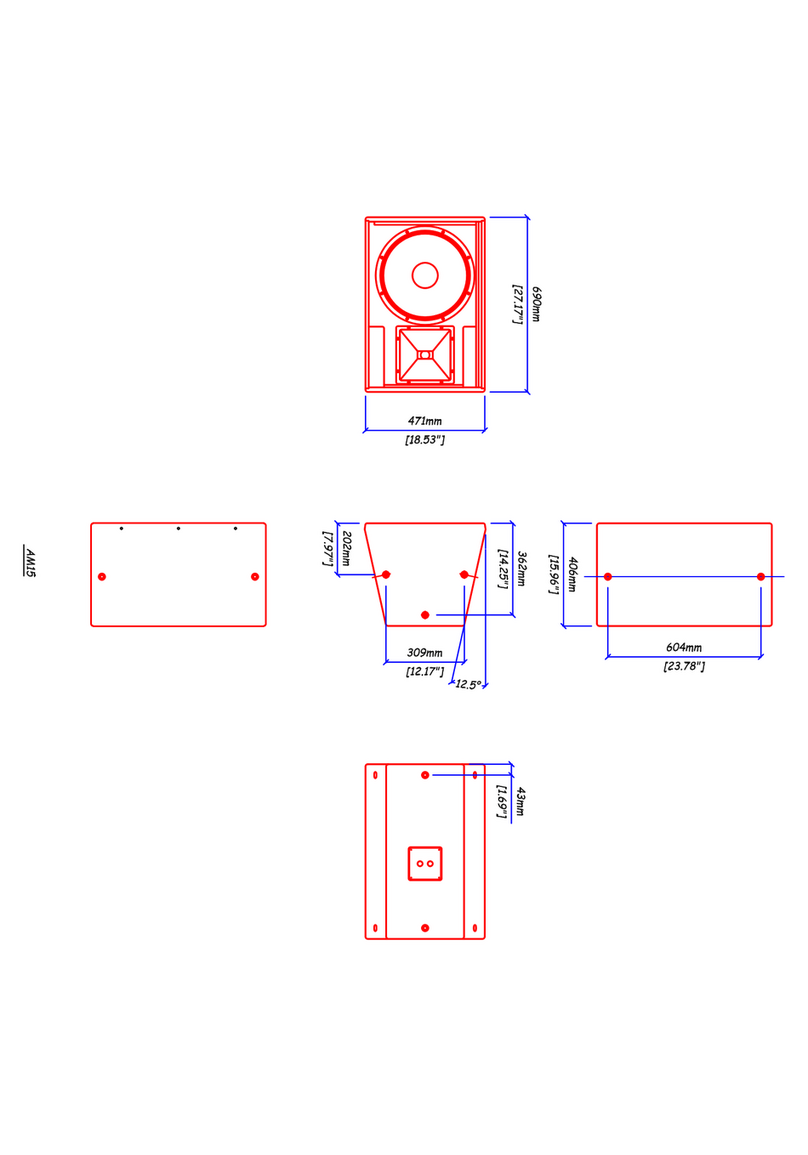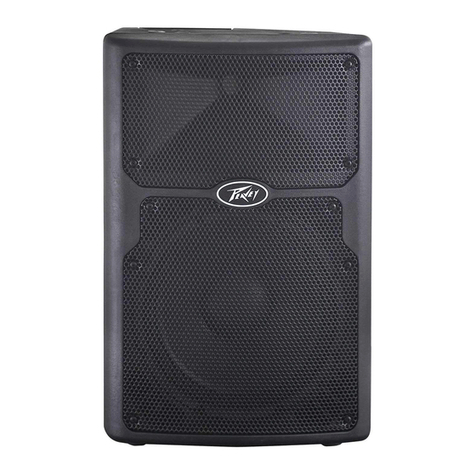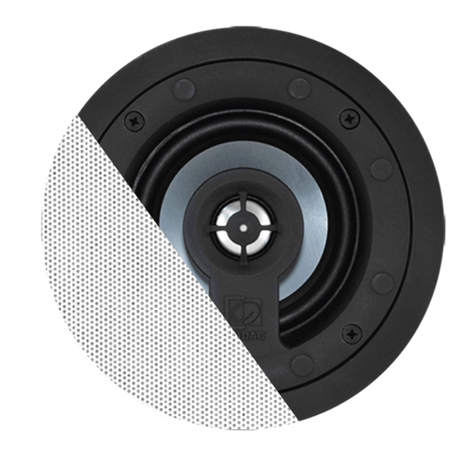Spendor S8e User manual

S8e User Manual Sheet 1 of 3
Loudspeaker positioning and room acoustics
All Spendor ‘S’ series loudspeakers are carefully engineered to suit a wide variety of listening rooms. Please
use the following guidelines to ensure they are correctly positioned in your room.
In any normal room a significant amount of sound is heard indirectly as reflected sound. When the reflections
are symmetrical for the left and right loudspeakers you will obtain the smoothest and clearest sound with the
most vivid stereo image. For a stereo music system try to position the loudspeakers either side of the room main
axis 2.0-2.4m apart and, if possible, at least 2.4m in front of the main seating area. The cabinets should be at
least 45cm away from any boundary wall. See Fig 1.
Figure 1 Single fixed position may be ‘Toe-in’ –a convenient
too restrictive for domestic listening way to increase the listening area
As a loudspeaker is moved close to a wall or corner you will notice the bass level appears to increase. This is
the result of low frequency sound reflection. Although the bass output in some frequency bands is increased,
there is cancellation in the adjacent bands (Fig 2) and the sound can become uneven in character. If a
loudspeaker has to be placed close to a corner the distances from each surface should differ by at least 15cm.
This reduces the effect of phase (time) delays between sound reflections from the side and rear walls and the
sound radiated directly by the loudspeaker to minimise peaks and dips in the sound. Tip: Ask someone to speak
normally in your room. Then ask them to speak with their head close to a room corner, you will notice the sound
becomes heavy and muddled. A loudspeaker is affected in exactly the same way and you will know immediately
why a loudspeaker should not be positioned tight in a corner!
Optimum room position
Corner position
Figure 2 Loudspeaker Response Curves
Mid and high frequency reflections from a close wall or large reflective (hard) surface can impair the stereo
image and obvious or more subtle ‘echoes’ may cause the sound to lose its clear and smooth quality. Ideally
your room should have a good mix of hard and absorbent surfaces to even out and randomise any reflections
and room resonances. Absorbent furnishings, drapes, carpets and wall rugs can be very effective. Do not place
loudspeakers immediately adjacent to very absorbent soft furnishings or the sound may become unnaturally
dull. Irregular surfaces like book shelves can help to improve the room acoustics.
As soon as you are familiar with your new loudspeakers spend a little time experimenting with different
positioning while listening to some of your favourite music. A small adjustment can often result in a large
improvement.
For multi-channel surround sound or home theatre installations it is often beneficial to position the loudspeakers
(including the centre channel and sub-woofer) assymetrically relative to the room main axis, your Spendor
dealer/installer will advise.

S8e User Manual Sheet 2 of 3
Basic connection and quick set-up
All loudspeakers need to be rigidly mounted to ensure a clean and clear sound. Always use the supplied
technical stabiliser and foot spikes. Switch off your amplifier(s). Check that the supplied terminal links are
installed between the HF and LF inputs. For information on bi-wiring and bi-amping see later. Always connect
the –ve (usually black) loudspeaker output terminal of the amplifier to the corresponding –ve (Black) terminal on
the loudspeaker. Always connect the +ve (usually red) loudspeaker output terminal of the amplifier to the
corresponding +ve (Red) terminal on the loudspeaker. Always connect the left channel amplifier output to the
left loudspeaker and the right channel amplifier output to the right loudspeaker. Make the connections as shown
below (Fig 3) only the left channel connection is shown. Turn the volume control down and switch on the
amplifier. Pick a source (CD, FM etc.) and advance the volume control carefully.
Left Channel Loudspeaker
Terminal Links in place
Figure 3 Loudspeaker Connections–Single Wiring
Bi-wiring
Bi-wiring improves sound quality by separating the current paths for Low (LF) and High (HF) frequencies. Make
the connections as shown below (Fig 4) only the left channel connection is shown. Store the terminal links
safely.
Left Channel Loudspeaker
Terminal Links Removed
Figure 4 Loudspeaker Connections for Bi-wiring
Bi-amping
Bi-amping allows two independent audio power amplifier of equal or similar quality to be used for LF and HF
signals. The benefits of bi-amping include reduced intermodulation distortion because the low and high
frequency signals are amplified independently, and more power reserve and dynamic range because each
amplifier has less ‘work’ to do than a corresponding single amplifier. For bi-amping make the connections as
shown below (Fig 5), only the left channel connection is shown. Terminal links MUST be removed before bi-
amping. Store the terminal links safely.
Left Channel Loudspeaker
Terminal Links Removed
Figure 5 Loudspeaker Connections for Bi-amping
Amplifier Left Channel Output
Amplifier Left Channel Output
HF Amplifier (Left Channel) LF Amplifier (Left Channel)
HF Amplifier (Left Channel) LF Amplifier (Left Channel)

S8e User Manual Sheet 3 of 3
Cable Quality
Loudspeaker cables can have an important effect on sound quality. Choose good quality low resistance cables
with high purity metal conductors and low-loss dielectric (insulation). Ask your dealer for advice on cables to suit
your system and budget.
Loudspeaker Power Rating
The technical specification shows a nominal power rating for your loudspeaker and the figure can be taken as a
rough guide to the power rating (Watts per channel into 8ohm load) for a complementary amplifier. However,
provided you NEVER play at levels were the sound is strained or distorted, the power rating is not critical
provided you have a minimum of about 15 Watts per channel and a maximum of 300 Watts per channel
available. If the sound is strained always turn the playing level down immediately. Ask your dealer for advice if
you are unsure or if you are choosing a new amplifier.
Caring for your Loudspeakers
Spendor’s real wood veneers and solid timber elements should be treated like high quality furniture. Routine
dusting with a soft cloth is recommended. Do not apply any aerosol spray directly as this could damage the
drive units or grille fabric. Dust on the grille cloth can be removed with a sticky roller or a piece of sticky tape or
by gentle vacuuming with a soft brush adaptor. Do not expose the cabinets to damp, widely fluctuating
temperatures or direct sunlight, appearance and performance may suffer. Spendor ‘S’ series cabinets are
finished in natural wood, over time the wood will age and mature, evening out and often darkening the surface
colour while highlighting the natural grain and patina.
Queries and Service
If you require advice or service on your audio system please contact your Spendor dealer. We recommend that
you retain all the packaging for your loudspeakers in case you need to transport them safely in the future.
Warranty
All Spendor ‘S’ Series loudspeakers (The Equipment) are guaranteed against defects in components and
materials for a period of 5 years from date of purchase. Within this period parts will be replaced free of charge
provided that failure is not due to accident, negligence or misuse. Labour and carriage are not covered except
by local agreement. The guarantee offered does not affect the consumer’s statutory rights. To obtain Service
under guarantee the equipment together with an original or clear copy of proof of purchase must be delivered to
a local Spendor dealer or distributor at the owner’s expense. Spendor Audio Systems Ltd and any of its
authorised distributors or dealers reserve the right to refuse service under guarantee if the equipment has been
subject to unauthorised modification or any of the serial numbers identifying the equipment have been defaced
or removed.
Please register ownership of your Spendor loudspeakers by completing and returning the enclosed registration
card. This will help us to deal quickly with any queries regarding your equipment.
Specification Spendor S8e
Description 2 way floor standing loudspeaker
Enclosure type Spendor 3D linear flow reflex
Drive unit HF 27mm coated fabric dome, damped vented enclosure
Drive unit LF/MF 210mm ep38 polymer cone
Frequency response 44Hz -20kHz ±3dB on reference axis
Frequency range -6dB at 32Hz
Dispersion Within 3dB of response on reference axis
Horizontal over 40oarc ± 20o
Vertical over 20oarc ± 10o
Sensitivity for 1W @ 1m 89dB
Impedance nominal 8 ohms
Impedance minimum 5.0 ohms
Crossover frequencies 4.0kHz
Power handling 15-300 watts into 8 ohms unclipped
Harmonic distortion < 1% 100Hz-20kHz 90dB @ 1m
Connections 2/3 way gold-plated bi-wirable terminals
Magnetic shieldoing All drive units shielded
Dimensions H x W x D 925 x 226 x 320mm (36.4 x 8.9 x 12.6 in)
Plinth maximum W x D 316 x 340mm (12.4 x 13.4 in)
Spikes/feet/stand height 37 ± 3mm
Net weight 25.0kg (55.1 lb)
Shipping weight 28.0kg (61.7 lb)
Accessories supplied Spikes and lock nuts
Cabinet real wood finishes Cherry, Maple, Rosenut, Black ash
Spendor Loudspeakers are designed and manufactured in the UK by Spendor Audio Systems Ltd
Spendor Audio Systems Ltd reserve the right to alter designs and specifications without notice.
® Spendor is a registered trademark of Spendor Audio Systems Ltd. Kevlar is a registered trademark of DuPont.
© Copyright 2003 Spendor Audio Systems Ltd. All rights reserved.
305VER1.DOC
Spendor Audio Systems Limited
Station Road Industrial Estate
Hailsham
East Sussex
BN27 2ER UK
Tel: +44 (0)1323 843474
Fax: +44 (0)1323 442254
Web Site: www.spendoraudio.com
Table of contents
Other Spendor Speakers manuals



